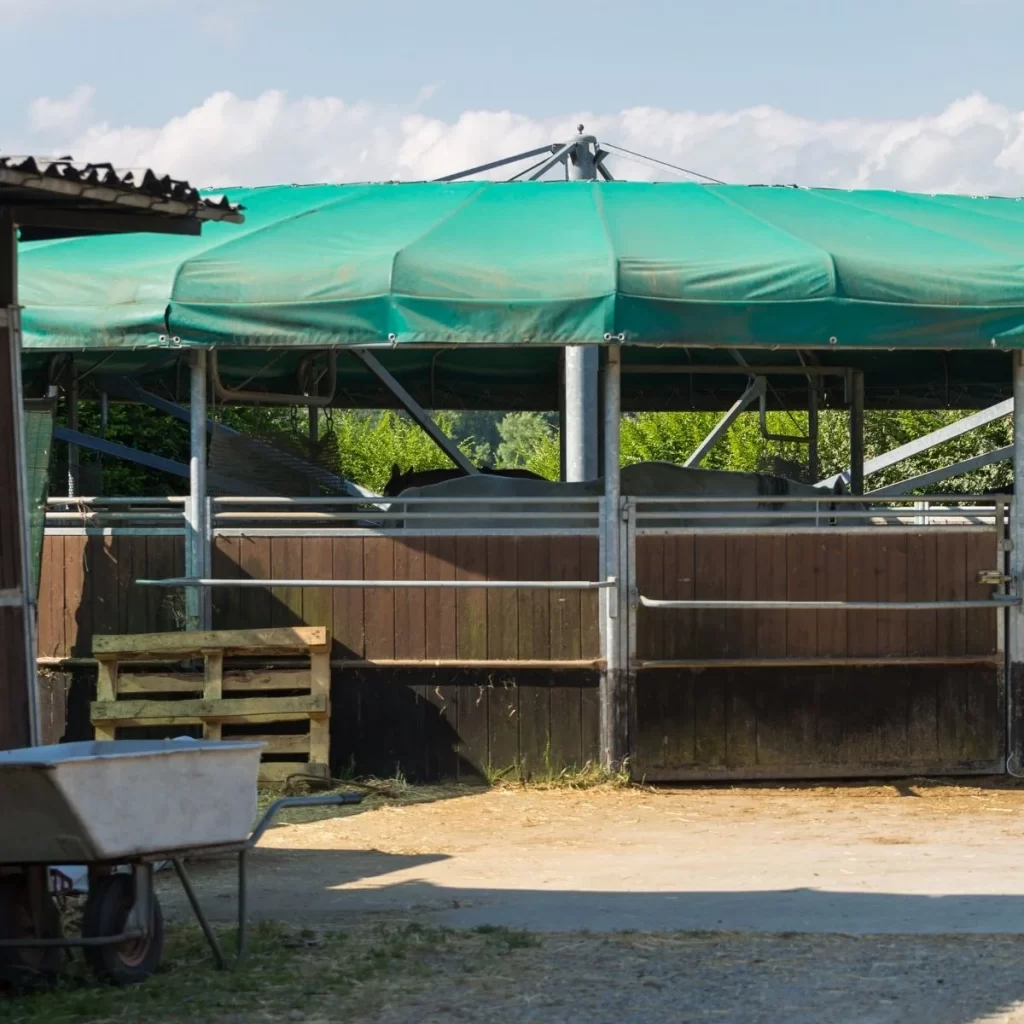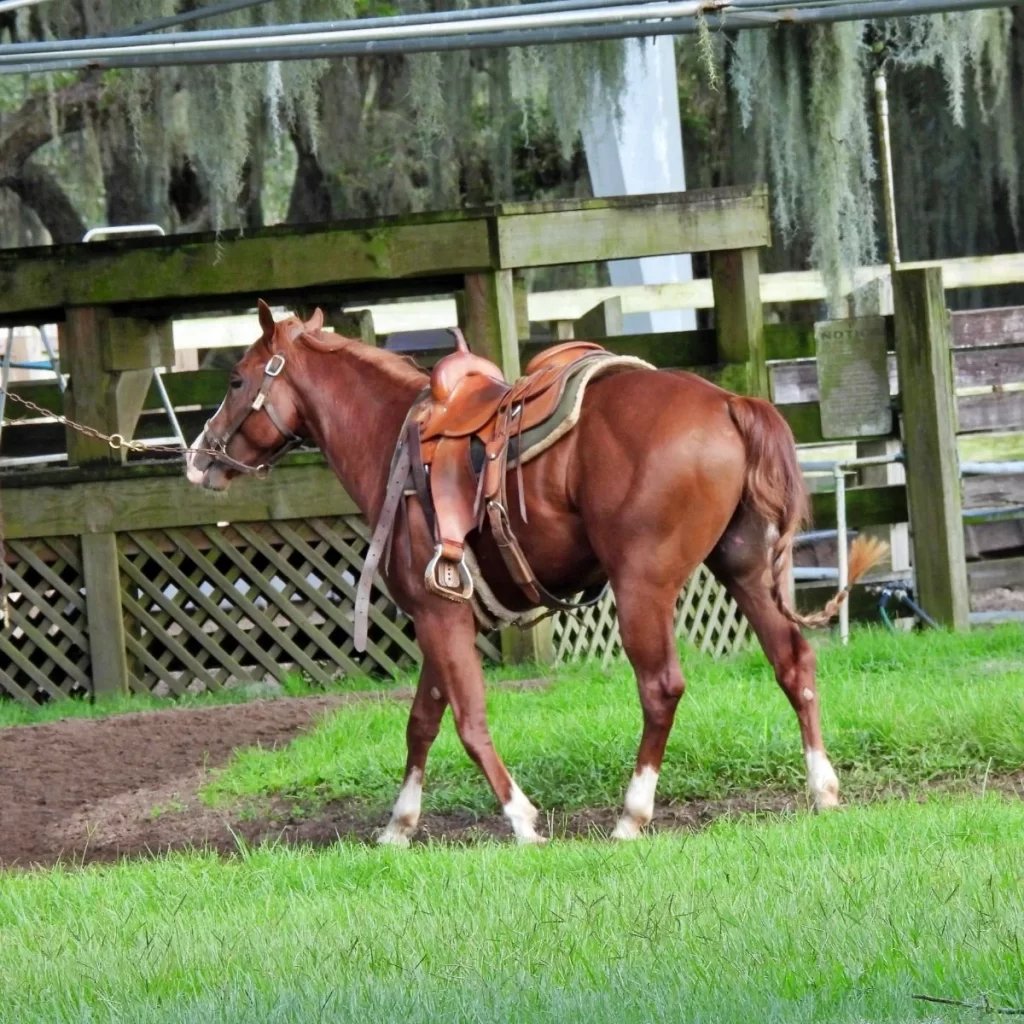What is a hot walker for horses? What is hot walking a horse? What is a hot walker?
New horse owners will always look in amazement the first time they see a horse hot walker.
I'm always immediately asked several questions by them, especially when they see it in action, loaded with horses.
To help out other equestrians who might not know about horse walkers, I've put together this short guide.
Let's get started and by the end you'll probably one a hot walker of your own!
What is a Horse Walker?
A horse walker is a circular tool that runs on a motor. They come in several different models. The simplest type has arms that extend from the center and a rope where you tie the horse. Some of these models might not even have a motor and move when the horse moves.

These types of walkers often don’t even have an outer wall.
As you can imagine, an exuberant horse in this environment can get a little hairy!
They are a viable option if you have a lower budget but I always suggest going for the most complex design you can afford. They are more versatile and safer!
More intricate models have dividers made of grills on the top and flexible rubber on the bottom. They are surrounded by a circular outer wall, sometimes made of heavy duty rubber.
They essential create individual stalls for the horse. I much prefer this type of horse walker as you do not need to tie the horse and they are separated from the other horses.
This makes them much safer and also more secure. Once the horse is in the walker you turn it on and it keeps the horse walking on a circle.
The best horse walkers have different speed settings and allow you to change directions. With a faster speed, you can move the horse in a strong, forward walk.
You will see hot walkers that don’t have a roof, while others are covered. Having a covered horse walker is much better as you can use it in all weather conditions. Of course, for everyone's safety avoid going out in extreme weather situations.
The walking surface is sometimes sand like you’d see in a riding arena. Fancier models will have special rubber tiles designs specifically for horse walkers.
What Are Horse Hot Walkers Used for?
Hot walkers are used for several purposes in the daily care of horses. The general use is to provide a way to exercise horses. Because you can set the speed on many models, you can keep the horse walking at a steady pace for a set amount of time.

I find them excellent for bad weather. It means you get the horses out of their stables and moving when otherwise they might be stuck in. They provide great controlled exercise.
They are also used to warm up a horse before riding. A good brisk walk is a great way to let a horse stretch out and warm its muscles up before doing more intensive work.
In addition to warming up a horse, walkers are also used to cool down horses. After work out it is important that horses are cooled down correctly. This allows their muscles and respiratory system to recover. It also lessens the likelihood of post-training soreness.
Another fantastic reason hot walkers are used is for a horse in rehabilitation.
Horses that need slow, moderate exercise can go on a walker for this. It prevents them from running or bucking too much on the lunge or in the paddock when that behavior would be detrimental to their recovery.
How To Use A Horse Walker? Hartpury College shows you how to use one type in this introductory video.
https://www.youtube.com/watch?v=pwadKsgSy7Q
What Are the Benefits of Horse Walkers?
The benefits of horse walkers are what make them so popular as an exercise solution. They allow equestrians to exercise multiple horses at the same time. Walkers are also time savers.
A busy rider can put their horse on the walker to cool down instead of riding for this process, allowing them to get on their next horse quicker.
As I’ve already mentioned they provide controlled exercise and if they are covered allow a way to get fully-grown or adult aged horses out of their stables in poor weather.
They also are a way to slowly condition horses and provide additional exercise.
Dr. Brian Nielson from Michigan State University explains the purpose and design of horse walkers.
https://www.youtube.com/watch?v=ZkAZpsc45hU
A study carried out by Hartpury College in the UK found that 20-minutes on a horse walker was the equivalent of 1-hour of turnout.
How Much Does a Horse Hot Walker Cost?
A horse hot walker is expensive. Even the basic models cost at least $5,000. For a common design, such as a six horse, enclosed walker with a roof, you can expect to pay around $25,000.
Walkers have a central motor, which you can access through a hidden door (if you have an enclosed walker).
By the entrance, is where the control panels are installed. They will have a power switch for electricity, a dial for speed, and a lever or some other way to stop and turn the walker around.
Are Walkers Bad for Horses?
Like everything, walkers should be used in moderation. Keep in mind that the horse is walking on a continuous circle in most cases, which is putting extra strain on their joints.
Very large walkers that take over six horses will usually have straight sides, which is better for the horses.
These are known as oval horse walkers. However, most people that don’t have a large stable will not need such a large hot walker. Plus these will be very expensive.
For circle walkers, the larger the circle the better it is for the horse. Tighter circles increase the pressure on joints. It is also important to use a walker that goes in both directions and split the horse’s time on it equally.
If you always go in one direction, you are creating an imbalance in the horse that is not healthy for it.
You also need to consider the age of the horse before putting it in a hot walker.
Horses under the age of 3 should never go on one. This is because their leg joints are still open and the continuous movement on a circle can cause damage.
Horse walkers are not harmless and you need to use them sensibly. A study about bone changes related to different types of exercise by several vets found that "Horse walker exercise led to relatively thicker lateral and medial SCB compared with the midline". However, this was much lower than high intensity exercise bone changes caused by racing or jumping.

However, in the horse racing industry, you will often see walkers used for very young horses to condition them for training or sales.
Another thing to consider is the size of the horse. Miniature horses shouldn't go on a walker as they are just too small to keep up with the pace and are small enough to get stuck under dividers.
Horse Hot Walker Risks
Horse hot walkers are not risk-free and there is still the potential for injury.
However, the fancier the walker, the safer it is. Simple walkers where you tie a horse are the least safe. First, the horse is tied to a moving object which can cause problems with a frisky horse or spooks.
Also, there is no divider between horses so kicks or other unwanted contacts can happen. If using this type of walker, always make sure the horse wears a breakaway halter.
A higher standard horse walker will contain the horse in its own compartment. The walls are high to prevent any escape. These enclosed horse walkers will also have an eclectic option which acts like an electric fence on the dividers.
This should prevent a horse from leaning on the divider or stopping, allowing it to pass over them. I’ve seen this happen! You would think a horse wouldn’t just stop, but on occasion, you get a cheeky individual.
It is also possible for a horse to slip and fall in a walker, especially if the surface gets wet and mucky from manure. It is important to keep the surface clean and as dry as possible.
A well constructed horse walker will not have any gaps that a horse could get a leg or their head stuck in. Always check this if you are thinking of getting one.
Because of the risks, though rare, you should never leave horses on a walker unattended. You should always be nearby so that you can stop it immediately if something happens.
For basic safety, all walkers need an emergency button or some kind of emergency cut-off switch.
FAQs
Still have some questions about horse walkers? Let’s take a look at some of the questions I’ve answered here.
Do you need planning permission for a horse walker?
Whether you need planning permission or not for a horse walker will depend on the laws in your locality.
Since a hot walker is a large, permanent fixture, many areas will require planning permission if you want to put one on your horse farm.
How long should a horse be on a hot walker?
Horses should be on a hot walker for 20 to 60 minutes, going an even amount of time in each direction. Some people will keep horses on them longer but I’m not convinced this is a good idea as far as joint health goes.
What is a Kraft horse walker?
A Kraft horse walker is a European design walker made in Germany. They build premium hot walkers to very high standards for the horse industry around the world.
Why do they walk horses in a circle after a race?
Horses are hand walked in a circle or around the shedrow after a race to cool them out. Racetracks are usually not equipped with motorized walkers, so this must be done by the horse’s groom.
Because galloping is such a strenuous exercise, walking helps the horse’s body return to normal. This is similar to human runners walking after they race. This process is known as hot walking horses. This video explains this job.
https://www.youtube.com/watch?v=RXYBtbMkJiI
Conclusion
Once you have a horse walker, you will never want to be without one.
They make life around the barn much easier and more efficient. The vast majority of horses learn how to go in a walker very quickly. It is rare that they don’t figure it out or are afraid.
I even know a horse that loves it so much that once he hears you turn it on he starts neighing and looking at you. He can’t wait to go on it!
References
- 1. Radford S. Study finds 20 minutes on a walker equivalent exercise to an hour’s turnout . Horse & Hound. 2019 . Available from: https://www.horseandhound.co.uk/news/study-finds-20-minutes-walker-equivalent-exercise-hours-turnout-696441
- 2. Murray RC, Branch MV, Dyson SJ, Parkin TDH, Goodship AE. How does exercise intensity and type affect equine distal tarsal subchondral bone thickness? Journal of Applied Physiology. 2007;102:2194–200.
- 3. Horsewalkers - should they be round or oval? | Trainer Magazine | European Trainer Article Index . Trainer Magazine. Available from: https://trainermagazine.com/european-trainer-articles/2013/8/8/horsewalkers-should-they-be-round-or-oval

Do you use horse hot walkers? Please share your experiences with us below!

